Research Proposal on Domestic Violence Against Women
VerifiedAdded on 2023/03/23
|17
|4491
|42
AI Summary
This research proposal explores the issue of domestic violence against women in Australia. It discusses the triggers of domestic violence, how victims combat it, and the effectiveness of law enforcement. The study aims to contribute to new knowledge and provide insights into this pressing issue.
Contribute Materials
Your contribution can guide someone’s learning journey. Share your
documents today.
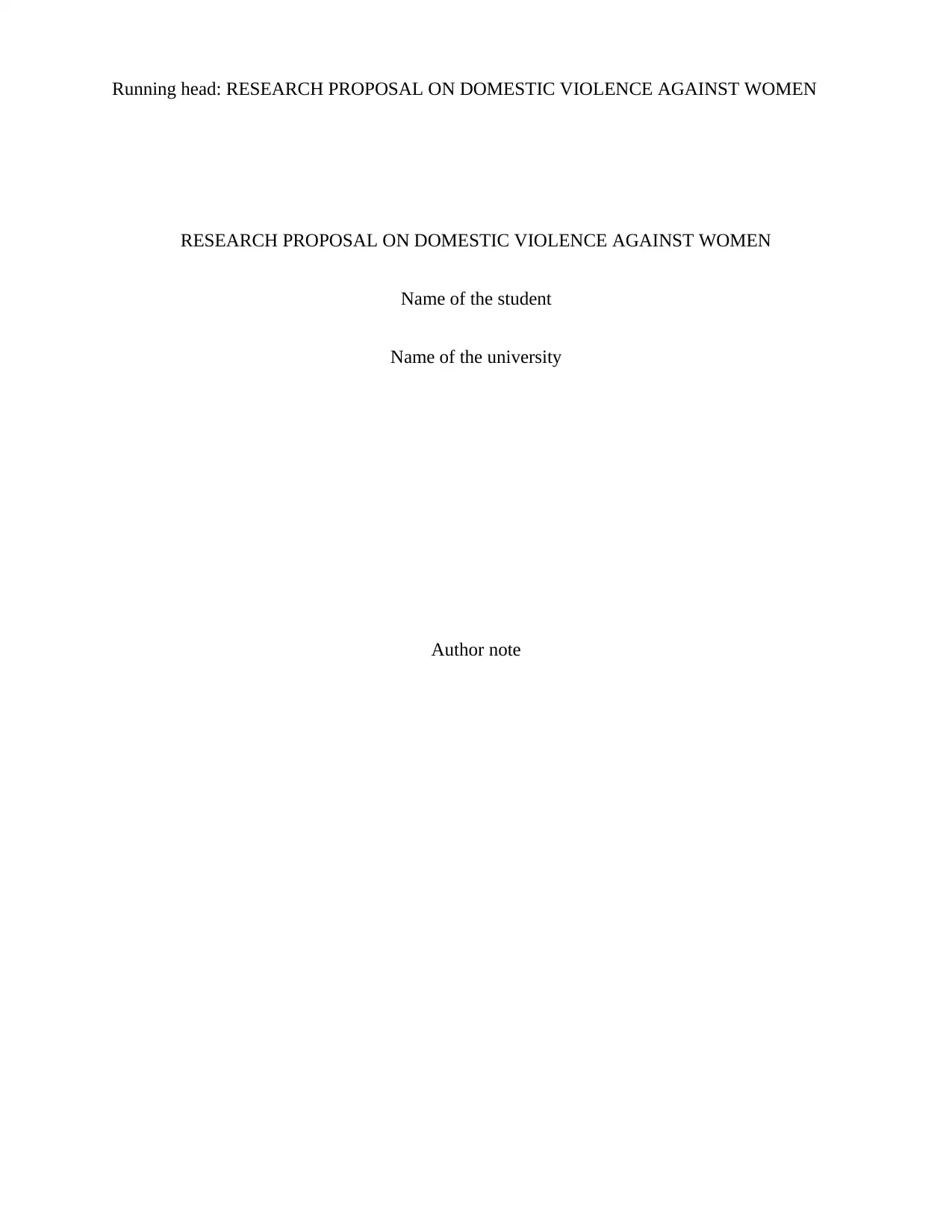
Running head: RESEARCH PROPOSAL ON DOMESTIC VIOLENCE AGAINST WOMEN
RESEARCH PROPOSAL ON DOMESTIC VIOLENCE AGAINST WOMEN
Name of the student
Name of the university
Author note
RESEARCH PROPOSAL ON DOMESTIC VIOLENCE AGAINST WOMEN
Name of the student
Name of the university
Author note
Secure Best Marks with AI Grader
Need help grading? Try our AI Grader for instant feedback on your assignments.
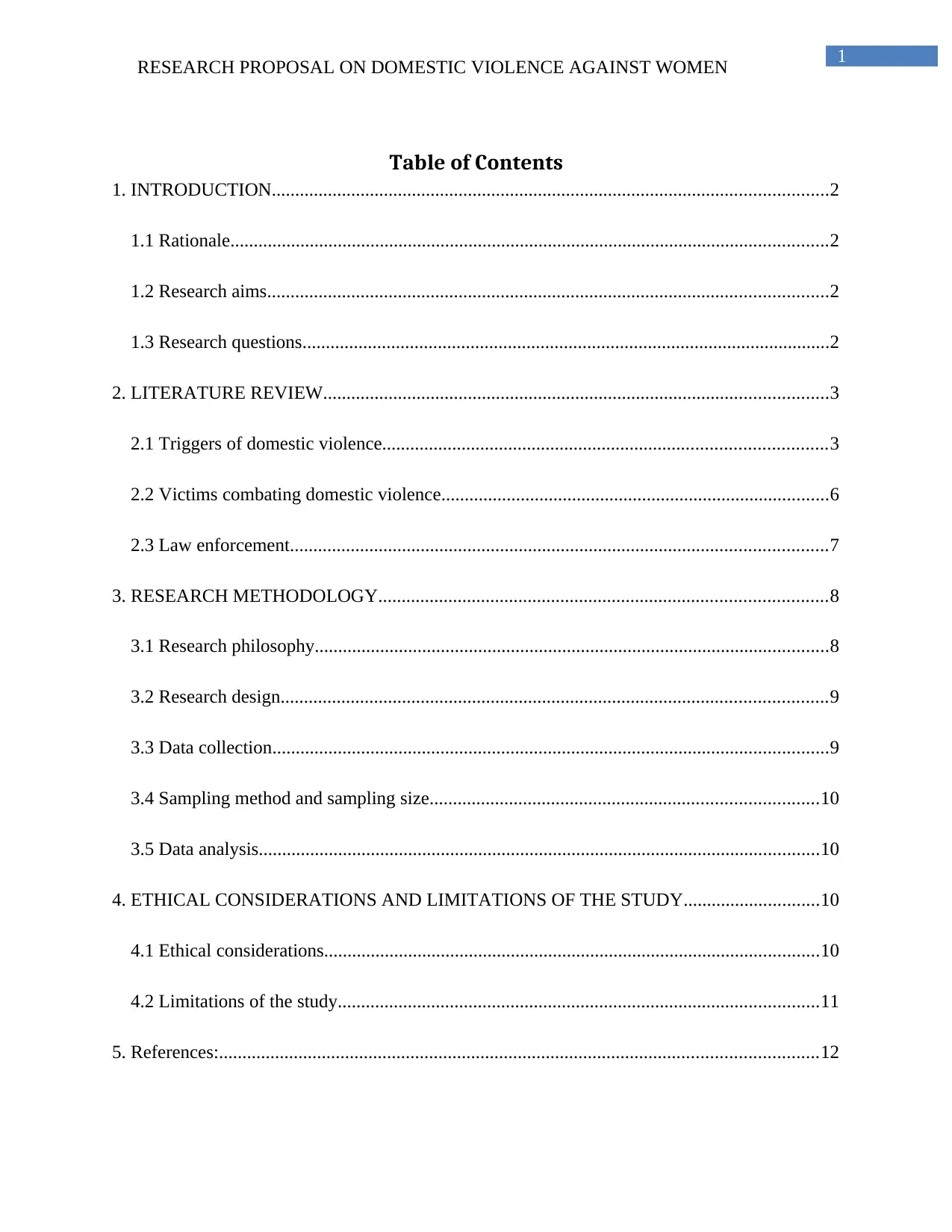
1
RESEARCH PROPOSAL ON DOMESTIC VIOLENCE AGAINST WOMEN
Table of Contents
1. INTRODUCTION.......................................................................................................................2
1.1 Rationale................................................................................................................................2
1.2 Research aims........................................................................................................................2
1.3 Research questions.................................................................................................................2
2. LITERATURE REVIEW............................................................................................................3
2.1 Triggers of domestic violence...............................................................................................3
2.2 Victims combating domestic violence...................................................................................6
2.3 Law enforcement...................................................................................................................7
3. RESEARCH METHODOLOGY................................................................................................8
3.1 Research philosophy..............................................................................................................8
3.2 Research design.....................................................................................................................9
3.3 Data collection.......................................................................................................................9
3.4 Sampling method and sampling size...................................................................................10
3.5 Data analysis........................................................................................................................10
4. ETHICAL CONSIDERATIONS AND LIMITATIONS OF THE STUDY.............................10
4.1 Ethical considerations..........................................................................................................10
4.2 Limitations of the study.......................................................................................................11
5. References:................................................................................................................................12
RESEARCH PROPOSAL ON DOMESTIC VIOLENCE AGAINST WOMEN
Table of Contents
1. INTRODUCTION.......................................................................................................................2
1.1 Rationale................................................................................................................................2
1.2 Research aims........................................................................................................................2
1.3 Research questions.................................................................................................................2
2. LITERATURE REVIEW............................................................................................................3
2.1 Triggers of domestic violence...............................................................................................3
2.2 Victims combating domestic violence...................................................................................6
2.3 Law enforcement...................................................................................................................7
3. RESEARCH METHODOLOGY................................................................................................8
3.1 Research philosophy..............................................................................................................8
3.2 Research design.....................................................................................................................9
3.3 Data collection.......................................................................................................................9
3.4 Sampling method and sampling size...................................................................................10
3.5 Data analysis........................................................................................................................10
4. ETHICAL CONSIDERATIONS AND LIMITATIONS OF THE STUDY.............................10
4.1 Ethical considerations..........................................................................................................10
4.2 Limitations of the study.......................................................................................................11
5. References:................................................................................................................................12
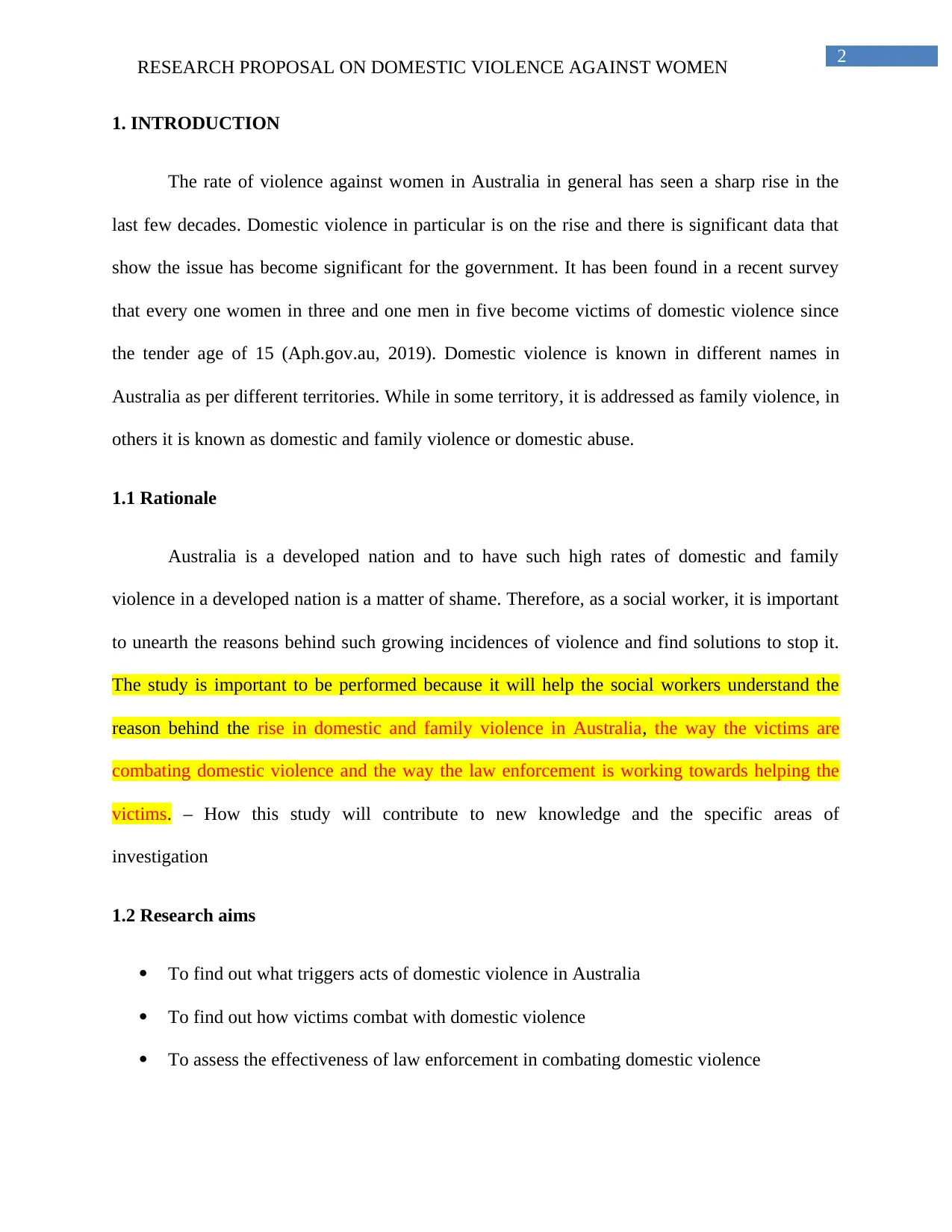
2
RESEARCH PROPOSAL ON DOMESTIC VIOLENCE AGAINST WOMEN
1. INTRODUCTION
The rate of violence against women in Australia in general has seen a sharp rise in the
last few decades. Domestic violence in particular is on the rise and there is significant data that
show the issue has become significant for the government. It has been found in a recent survey
that every one women in three and one men in five become victims of domestic violence since
the tender age of 15 (Aph.gov.au, 2019). Domestic violence is known in different names in
Australia as per different territories. While in some territory, it is addressed as family violence, in
others it is known as domestic and family violence or domestic abuse.
1.1 Rationale
Australia is a developed nation and to have such high rates of domestic and family
violence in a developed nation is a matter of shame. Therefore, as a social worker, it is important
to unearth the reasons behind such growing incidences of violence and find solutions to stop it.
The study is important to be performed because it will help the social workers understand the
reason behind the rise in domestic and family violence in Australia, the way the victims are
combating domestic violence and the way the law enforcement is working towards helping the
victims. – How this study will contribute to new knowledge and the specific areas of
investigation
1.2 Research aims
To find out what triggers acts of domestic violence in Australia
To find out how victims combat with domestic violence
To assess the effectiveness of law enforcement in combating domestic violence
RESEARCH PROPOSAL ON DOMESTIC VIOLENCE AGAINST WOMEN
1. INTRODUCTION
The rate of violence against women in Australia in general has seen a sharp rise in the
last few decades. Domestic violence in particular is on the rise and there is significant data that
show the issue has become significant for the government. It has been found in a recent survey
that every one women in three and one men in five become victims of domestic violence since
the tender age of 15 (Aph.gov.au, 2019). Domestic violence is known in different names in
Australia as per different territories. While in some territory, it is addressed as family violence, in
others it is known as domestic and family violence or domestic abuse.
1.1 Rationale
Australia is a developed nation and to have such high rates of domestic and family
violence in a developed nation is a matter of shame. Therefore, as a social worker, it is important
to unearth the reasons behind such growing incidences of violence and find solutions to stop it.
The study is important to be performed because it will help the social workers understand the
reason behind the rise in domestic and family violence in Australia, the way the victims are
combating domestic violence and the way the law enforcement is working towards helping the
victims. – How this study will contribute to new knowledge and the specific areas of
investigation
1.2 Research aims
To find out what triggers acts of domestic violence in Australia
To find out how victims combat with domestic violence
To assess the effectiveness of law enforcement in combating domestic violence
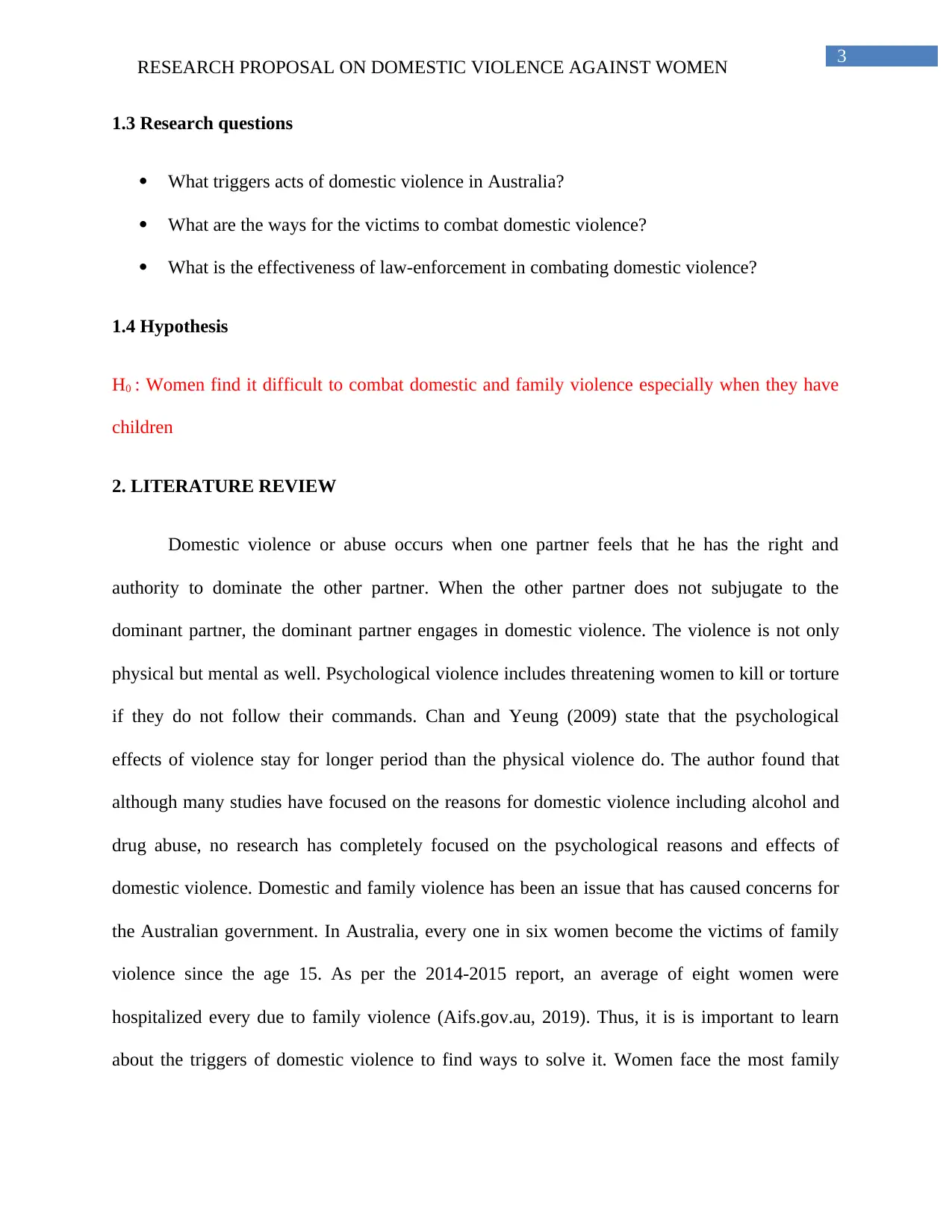
3
RESEARCH PROPOSAL ON DOMESTIC VIOLENCE AGAINST WOMEN
1.3 Research questions
What triggers acts of domestic violence in Australia?
What are the ways for the victims to combat domestic violence?
What is the effectiveness of law-enforcement in combating domestic violence?
1.4 Hypothesis
H0 : Women find it difficult to combat domestic and family violence especially when they have
children
2. LITERATURE REVIEW
Domestic violence or abuse occurs when one partner feels that he has the right and
authority to dominate the other partner. When the other partner does not subjugate to the
dominant partner, the dominant partner engages in domestic violence. The violence is not only
physical but mental as well. Psychological violence includes threatening women to kill or torture
if they do not follow their commands. Chan and Yeung (2009) state that the psychological
effects of violence stay for longer period than the physical violence do. The author found that
although many studies have focused on the reasons for domestic violence including alcohol and
drug abuse, no research has completely focused on the psychological reasons and effects of
domestic violence. Domestic and family violence has been an issue that has caused concerns for
the Australian government. In Australia, every one in six women become the victims of family
violence since the age 15. As per the 2014-2015 report, an average of eight women were
hospitalized every due to family violence (Aifs.gov.au, 2019). Thus, it is is important to learn
about the triggers of domestic violence to find ways to solve it. Women face the most family
RESEARCH PROPOSAL ON DOMESTIC VIOLENCE AGAINST WOMEN
1.3 Research questions
What triggers acts of domestic violence in Australia?
What are the ways for the victims to combat domestic violence?
What is the effectiveness of law-enforcement in combating domestic violence?
1.4 Hypothesis
H0 : Women find it difficult to combat domestic and family violence especially when they have
children
2. LITERATURE REVIEW
Domestic violence or abuse occurs when one partner feels that he has the right and
authority to dominate the other partner. When the other partner does not subjugate to the
dominant partner, the dominant partner engages in domestic violence. The violence is not only
physical but mental as well. Psychological violence includes threatening women to kill or torture
if they do not follow their commands. Chan and Yeung (2009) state that the psychological
effects of violence stay for longer period than the physical violence do. The author found that
although many studies have focused on the reasons for domestic violence including alcohol and
drug abuse, no research has completely focused on the psychological reasons and effects of
domestic violence. Domestic and family violence has been an issue that has caused concerns for
the Australian government. In Australia, every one in six women become the victims of family
violence since the age 15. As per the 2014-2015 report, an average of eight women were
hospitalized every due to family violence (Aifs.gov.au, 2019). Thus, it is is important to learn
about the triggers of domestic violence to find ways to solve it. Women face the most family
Secure Best Marks with AI Grader
Need help grading? Try our AI Grader for instant feedback on your assignments.
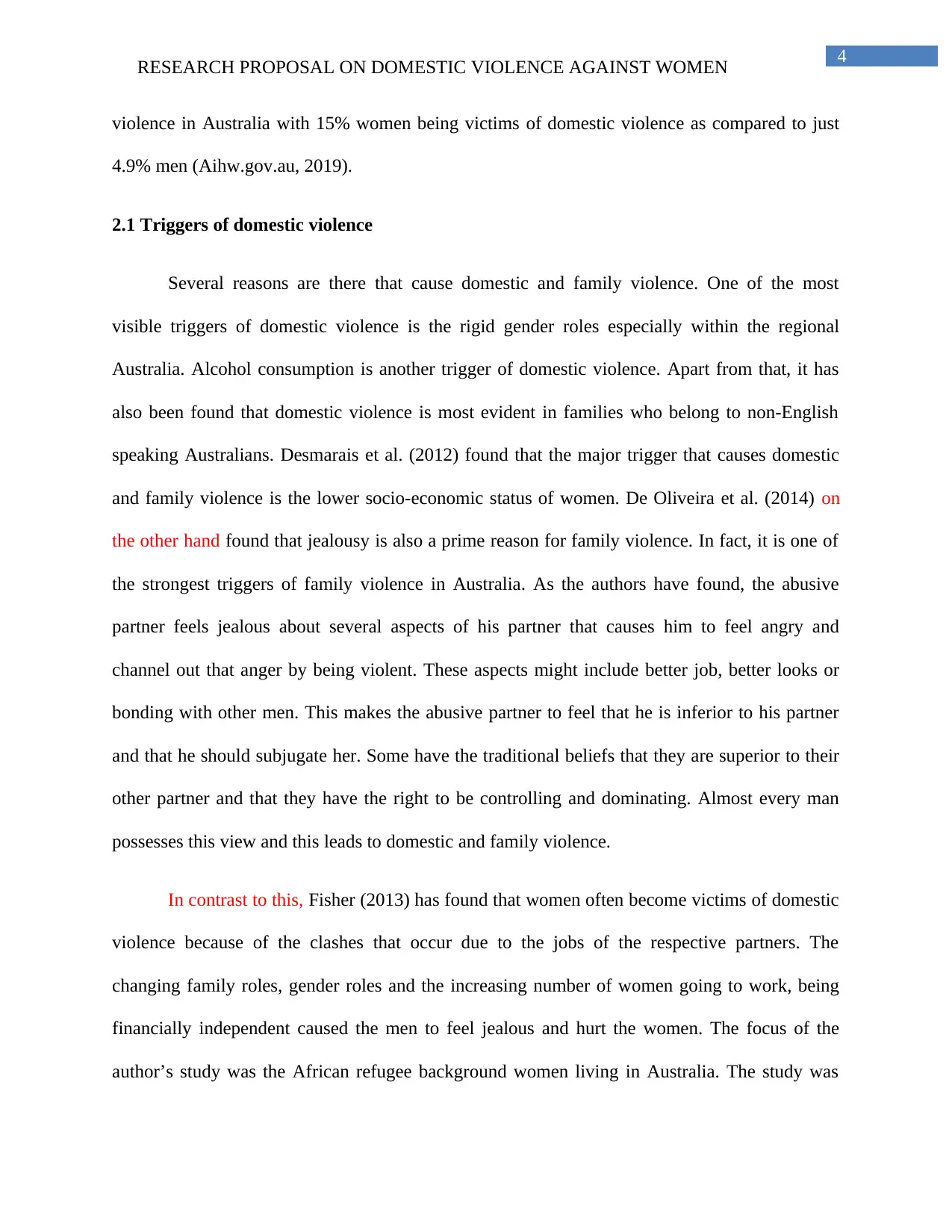
4
RESEARCH PROPOSAL ON DOMESTIC VIOLENCE AGAINST WOMEN
violence in Australia with 15% women being victims of domestic violence as compared to just
4.9% men (Aihw.gov.au, 2019).
2.1 Triggers of domestic violence
Several reasons are there that cause domestic and family violence. One of the most
visible triggers of domestic violence is the rigid gender roles especially within the regional
Australia. Alcohol consumption is another trigger of domestic violence. Apart from that, it has
also been found that domestic violence is most evident in families who belong to non-English
speaking Australians. Desmarais et al. (2012) found that the major trigger that causes domestic
and family violence is the lower socio-economic status of women. De Oliveira et al. (2014) on
the other hand found that jealousy is also a prime reason for family violence. In fact, it is one of
the strongest triggers of family violence in Australia. As the authors have found, the abusive
partner feels jealous about several aspects of his partner that causes him to feel angry and
channel out that anger by being violent. These aspects might include better job, better looks or
bonding with other men. This makes the abusive partner to feel that he is inferior to his partner
and that he should subjugate her. Some have the traditional beliefs that they are superior to their
other partner and that they have the right to be controlling and dominating. Almost every man
possesses this view and this leads to domestic and family violence.
In contrast to this, Fisher (2013) has found that women often become victims of domestic
violence because of the clashes that occur due to the jobs of the respective partners. The
changing family roles, gender roles and the increasing number of women going to work, being
financially independent caused the men to feel jealous and hurt the women. The focus of the
author’s study was the African refugee background women living in Australia. The study was
RESEARCH PROPOSAL ON DOMESTIC VIOLENCE AGAINST WOMEN
violence in Australia with 15% women being victims of domestic violence as compared to just
4.9% men (Aihw.gov.au, 2019).
2.1 Triggers of domestic violence
Several reasons are there that cause domestic and family violence. One of the most
visible triggers of domestic violence is the rigid gender roles especially within the regional
Australia. Alcohol consumption is another trigger of domestic violence. Apart from that, it has
also been found that domestic violence is most evident in families who belong to non-English
speaking Australians. Desmarais et al. (2012) found that the major trigger that causes domestic
and family violence is the lower socio-economic status of women. De Oliveira et al. (2014) on
the other hand found that jealousy is also a prime reason for family violence. In fact, it is one of
the strongest triggers of family violence in Australia. As the authors have found, the abusive
partner feels jealous about several aspects of his partner that causes him to feel angry and
channel out that anger by being violent. These aspects might include better job, better looks or
bonding with other men. This makes the abusive partner to feel that he is inferior to his partner
and that he should subjugate her. Some have the traditional beliefs that they are superior to their
other partner and that they have the right to be controlling and dominating. Almost every man
possesses this view and this leads to domestic and family violence.
In contrast to this, Fisher (2013) has found that women often become victims of domestic
violence because of the clashes that occur due to the jobs of the respective partners. The
changing family roles, gender roles and the increasing number of women going to work, being
financially independent caused the men to feel jealous and hurt the women. The focus of the
author’s study was the African refugee background women living in Australia. The study was
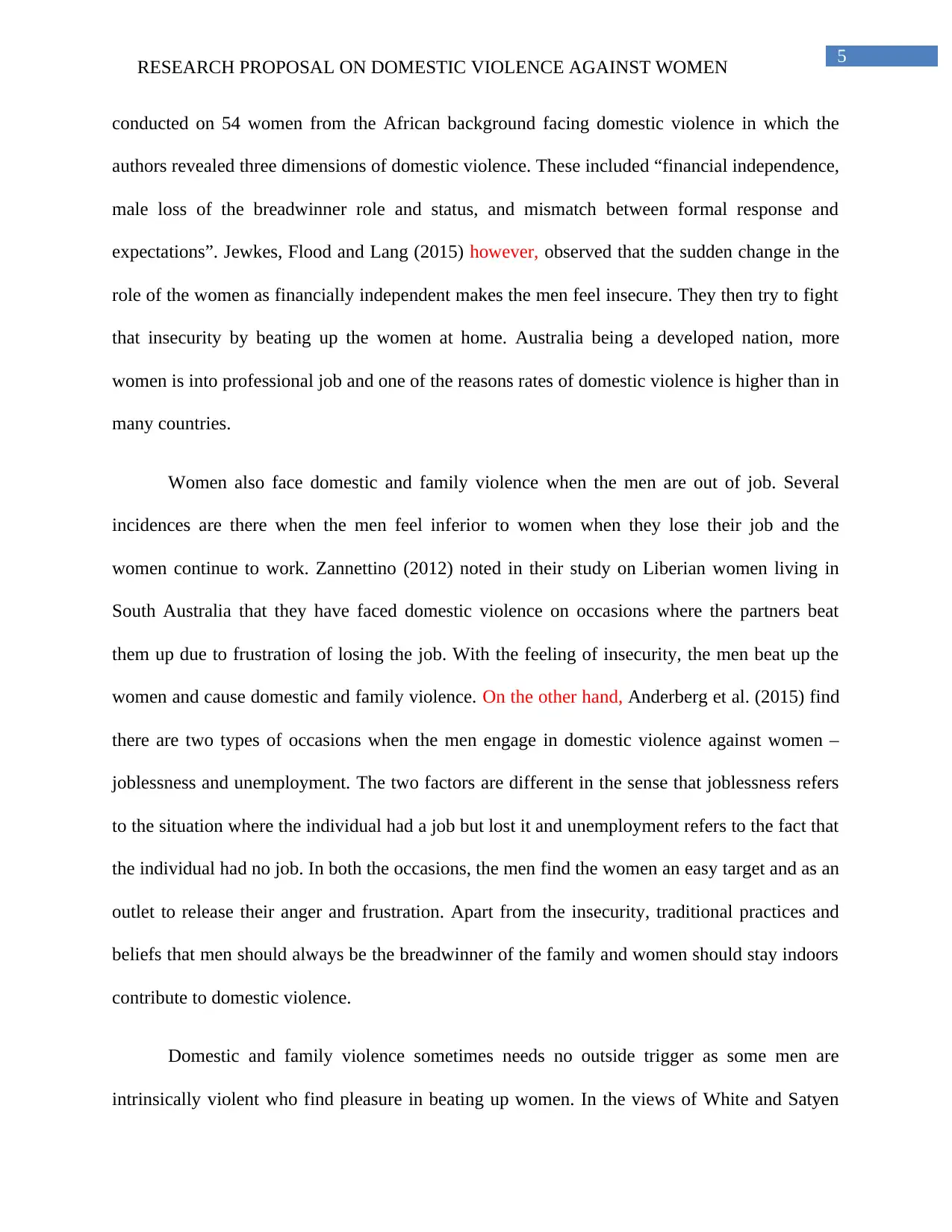
5
RESEARCH PROPOSAL ON DOMESTIC VIOLENCE AGAINST WOMEN
conducted on 54 women from the African background facing domestic violence in which the
authors revealed three dimensions of domestic violence. These included “financial independence,
male loss of the breadwinner role and status, and mismatch between formal response and
expectations”. Jewkes, Flood and Lang (2015) however, observed that the sudden change in the
role of the women as financially independent makes the men feel insecure. They then try to fight
that insecurity by beating up the women at home. Australia being a developed nation, more
women is into professional job and one of the reasons rates of domestic violence is higher than in
many countries.
Women also face domestic and family violence when the men are out of job. Several
incidences are there when the men feel inferior to women when they lose their job and the
women continue to work. Zannettino (2012) noted in their study on Liberian women living in
South Australia that they have faced domestic violence on occasions where the partners beat
them up due to frustration of losing the job. With the feeling of insecurity, the men beat up the
women and cause domestic and family violence. On the other hand, Anderberg et al. (2015) find
there are two types of occasions when the men engage in domestic violence against women –
joblessness and unemployment. The two factors are different in the sense that joblessness refers
to the situation where the individual had a job but lost it and unemployment refers to the fact that
the individual had no job. In both the occasions, the men find the women an easy target and as an
outlet to release their anger and frustration. Apart from the insecurity, traditional practices and
beliefs that men should always be the breadwinner of the family and women should stay indoors
contribute to domestic violence.
Domestic and family violence sometimes needs no outside trigger as some men are
intrinsically violent who find pleasure in beating up women. In the views of White and Satyen
RESEARCH PROPOSAL ON DOMESTIC VIOLENCE AGAINST WOMEN
conducted on 54 women from the African background facing domestic violence in which the
authors revealed three dimensions of domestic violence. These included “financial independence,
male loss of the breadwinner role and status, and mismatch between formal response and
expectations”. Jewkes, Flood and Lang (2015) however, observed that the sudden change in the
role of the women as financially independent makes the men feel insecure. They then try to fight
that insecurity by beating up the women at home. Australia being a developed nation, more
women is into professional job and one of the reasons rates of domestic violence is higher than in
many countries.
Women also face domestic and family violence when the men are out of job. Several
incidences are there when the men feel inferior to women when they lose their job and the
women continue to work. Zannettino (2012) noted in their study on Liberian women living in
South Australia that they have faced domestic violence on occasions where the partners beat
them up due to frustration of losing the job. With the feeling of insecurity, the men beat up the
women and cause domestic and family violence. On the other hand, Anderberg et al. (2015) find
there are two types of occasions when the men engage in domestic violence against women –
joblessness and unemployment. The two factors are different in the sense that joblessness refers
to the situation where the individual had a job but lost it and unemployment refers to the fact that
the individual had no job. In both the occasions, the men find the women an easy target and as an
outlet to release their anger and frustration. Apart from the insecurity, traditional practices and
beliefs that men should always be the breadwinner of the family and women should stay indoors
contribute to domestic violence.
Domestic and family violence sometimes needs no outside trigger as some men are
intrinsically violent who find pleasure in beating up women. In the views of White and Satyen
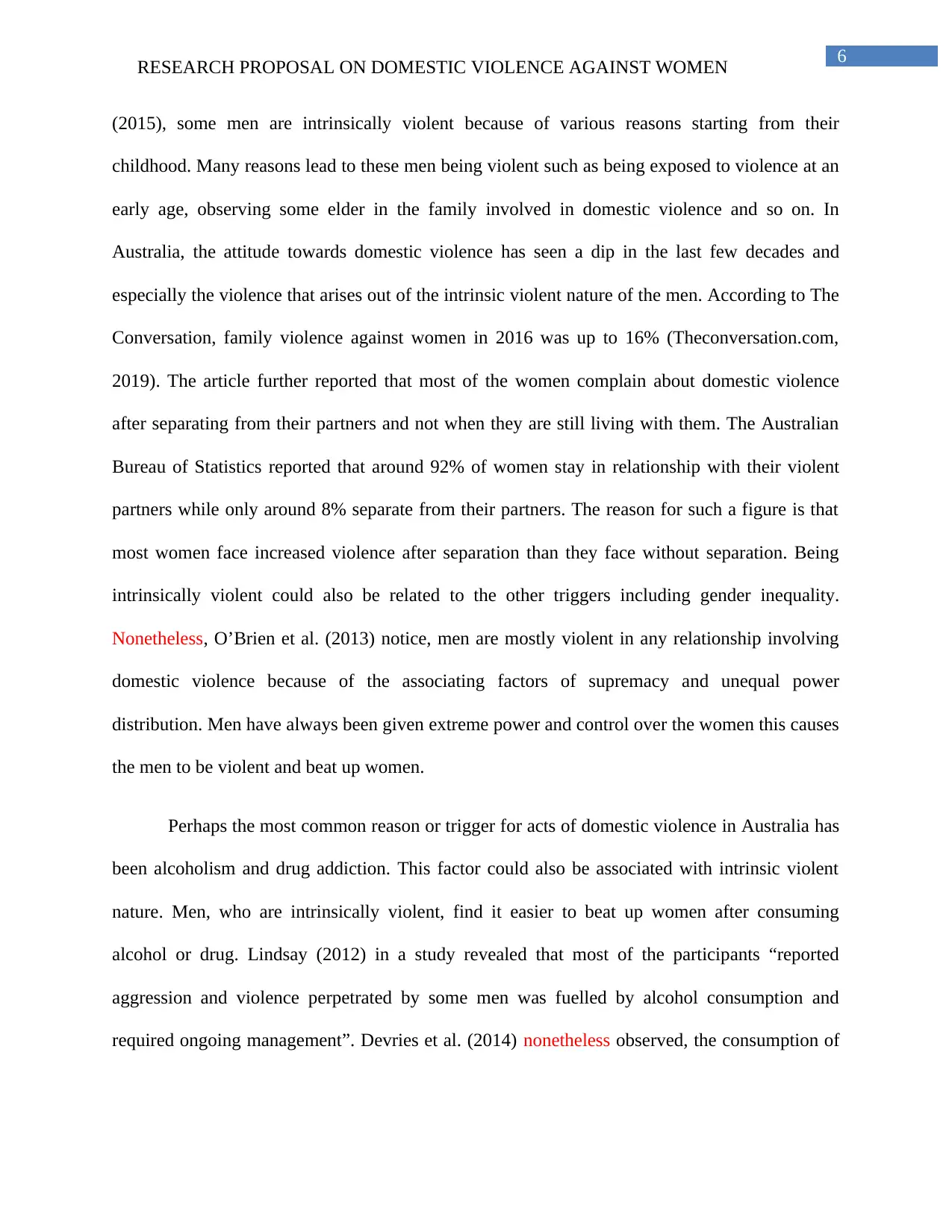
6
RESEARCH PROPOSAL ON DOMESTIC VIOLENCE AGAINST WOMEN
(2015), some men are intrinsically violent because of various reasons starting from their
childhood. Many reasons lead to these men being violent such as being exposed to violence at an
early age, observing some elder in the family involved in domestic violence and so on. In
Australia, the attitude towards domestic violence has seen a dip in the last few decades and
especially the violence that arises out of the intrinsic violent nature of the men. According to The
Conversation, family violence against women in 2016 was up to 16% (Theconversation.com,
2019). The article further reported that most of the women complain about domestic violence
after separating from their partners and not when they are still living with them. The Australian
Bureau of Statistics reported that around 92% of women stay in relationship with their violent
partners while only around 8% separate from their partners. The reason for such a figure is that
most women face increased violence after separation than they face without separation. Being
intrinsically violent could also be related to the other triggers including gender inequality.
Nonetheless, O’Brien et al. (2013) notice, men are mostly violent in any relationship involving
domestic violence because of the associating factors of supremacy and unequal power
distribution. Men have always been given extreme power and control over the women this causes
the men to be violent and beat up women.
Perhaps the most common reason or trigger for acts of domestic violence in Australia has
been alcoholism and drug addiction. This factor could also be associated with intrinsic violent
nature. Men, who are intrinsically violent, find it easier to beat up women after consuming
alcohol or drug. Lindsay (2012) in a study revealed that most of the participants “reported
aggression and violence perpetrated by some men was fuelled by alcohol consumption and
required ongoing management”. Devries et al. (2014) nonetheless observed, the consumption of
RESEARCH PROPOSAL ON DOMESTIC VIOLENCE AGAINST WOMEN
(2015), some men are intrinsically violent because of various reasons starting from their
childhood. Many reasons lead to these men being violent such as being exposed to violence at an
early age, observing some elder in the family involved in domestic violence and so on. In
Australia, the attitude towards domestic violence has seen a dip in the last few decades and
especially the violence that arises out of the intrinsic violent nature of the men. According to The
Conversation, family violence against women in 2016 was up to 16% (Theconversation.com,
2019). The article further reported that most of the women complain about domestic violence
after separating from their partners and not when they are still living with them. The Australian
Bureau of Statistics reported that around 92% of women stay in relationship with their violent
partners while only around 8% separate from their partners. The reason for such a figure is that
most women face increased violence after separation than they face without separation. Being
intrinsically violent could also be related to the other triggers including gender inequality.
Nonetheless, O’Brien et al. (2013) notice, men are mostly violent in any relationship involving
domestic violence because of the associating factors of supremacy and unequal power
distribution. Men have always been given extreme power and control over the women this causes
the men to be violent and beat up women.
Perhaps the most common reason or trigger for acts of domestic violence in Australia has
been alcoholism and drug addiction. This factor could also be associated with intrinsic violent
nature. Men, who are intrinsically violent, find it easier to beat up women after consuming
alcohol or drug. Lindsay (2012) in a study revealed that most of the participants “reported
aggression and violence perpetrated by some men was fuelled by alcohol consumption and
required ongoing management”. Devries et al. (2014) nonetheless observed, the consumption of
Paraphrase This Document
Need a fresh take? Get an instant paraphrase of this document with our AI Paraphraser
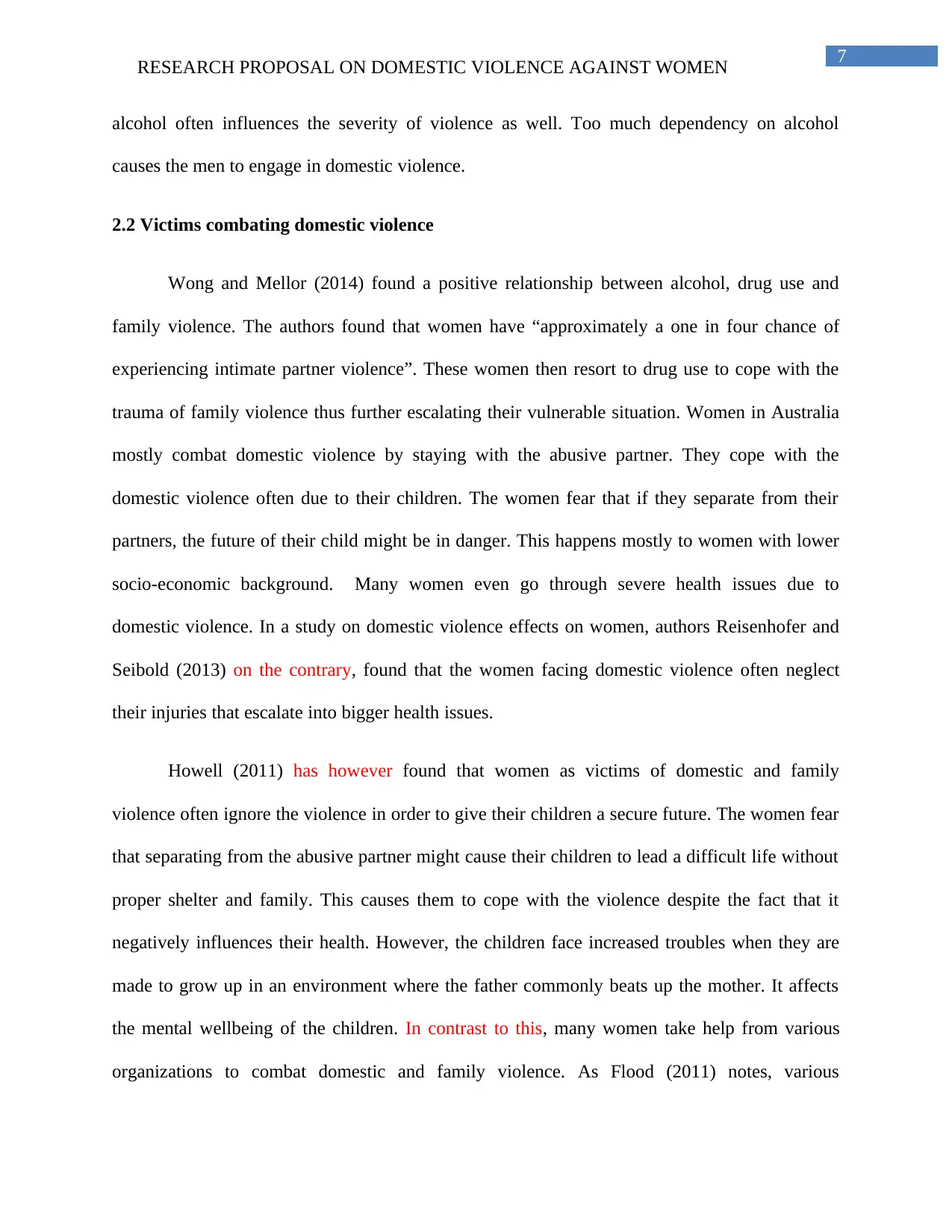
7
RESEARCH PROPOSAL ON DOMESTIC VIOLENCE AGAINST WOMEN
alcohol often influences the severity of violence as well. Too much dependency on alcohol
causes the men to engage in domestic violence.
2.2 Victims combating domestic violence
Wong and Mellor (2014) found a positive relationship between alcohol, drug use and
family violence. The authors found that women have “approximately a one in four chance of
experiencing intimate partner violence”. These women then resort to drug use to cope with the
trauma of family violence thus further escalating their vulnerable situation. Women in Australia
mostly combat domestic violence by staying with the abusive partner. They cope with the
domestic violence often due to their children. The women fear that if they separate from their
partners, the future of their child might be in danger. This happens mostly to women with lower
socio-economic background. Many women even go through severe health issues due to
domestic violence. In a study on domestic violence effects on women, authors Reisenhofer and
Seibold (2013) on the contrary, found that the women facing domestic violence often neglect
their injuries that escalate into bigger health issues.
Howell (2011) has however found that women as victims of domestic and family
violence often ignore the violence in order to give their children a secure future. The women fear
that separating from the abusive partner might cause their children to lead a difficult life without
proper shelter and family. This causes them to cope with the violence despite the fact that it
negatively influences their health. However, the children face increased troubles when they are
made to grow up in an environment where the father commonly beats up the mother. It affects
the mental wellbeing of the children. In contrast to this, many women take help from various
organizations to combat domestic and family violence. As Flood (2011) notes, various
RESEARCH PROPOSAL ON DOMESTIC VIOLENCE AGAINST WOMEN
alcohol often influences the severity of violence as well. Too much dependency on alcohol
causes the men to engage in domestic violence.
2.2 Victims combating domestic violence
Wong and Mellor (2014) found a positive relationship between alcohol, drug use and
family violence. The authors found that women have “approximately a one in four chance of
experiencing intimate partner violence”. These women then resort to drug use to cope with the
trauma of family violence thus further escalating their vulnerable situation. Women in Australia
mostly combat domestic violence by staying with the abusive partner. They cope with the
domestic violence often due to their children. The women fear that if they separate from their
partners, the future of their child might be in danger. This happens mostly to women with lower
socio-economic background. Many women even go through severe health issues due to
domestic violence. In a study on domestic violence effects on women, authors Reisenhofer and
Seibold (2013) on the contrary, found that the women facing domestic violence often neglect
their injuries that escalate into bigger health issues.
Howell (2011) has however found that women as victims of domestic and family
violence often ignore the violence in order to give their children a secure future. The women fear
that separating from the abusive partner might cause their children to lead a difficult life without
proper shelter and family. This causes them to cope with the violence despite the fact that it
negatively influences their health. However, the children face increased troubles when they are
made to grow up in an environment where the father commonly beats up the mother. It affects
the mental wellbeing of the children. In contrast to this, many women take help from various
organizations to combat domestic and family violence. As Flood (2011) notes, various
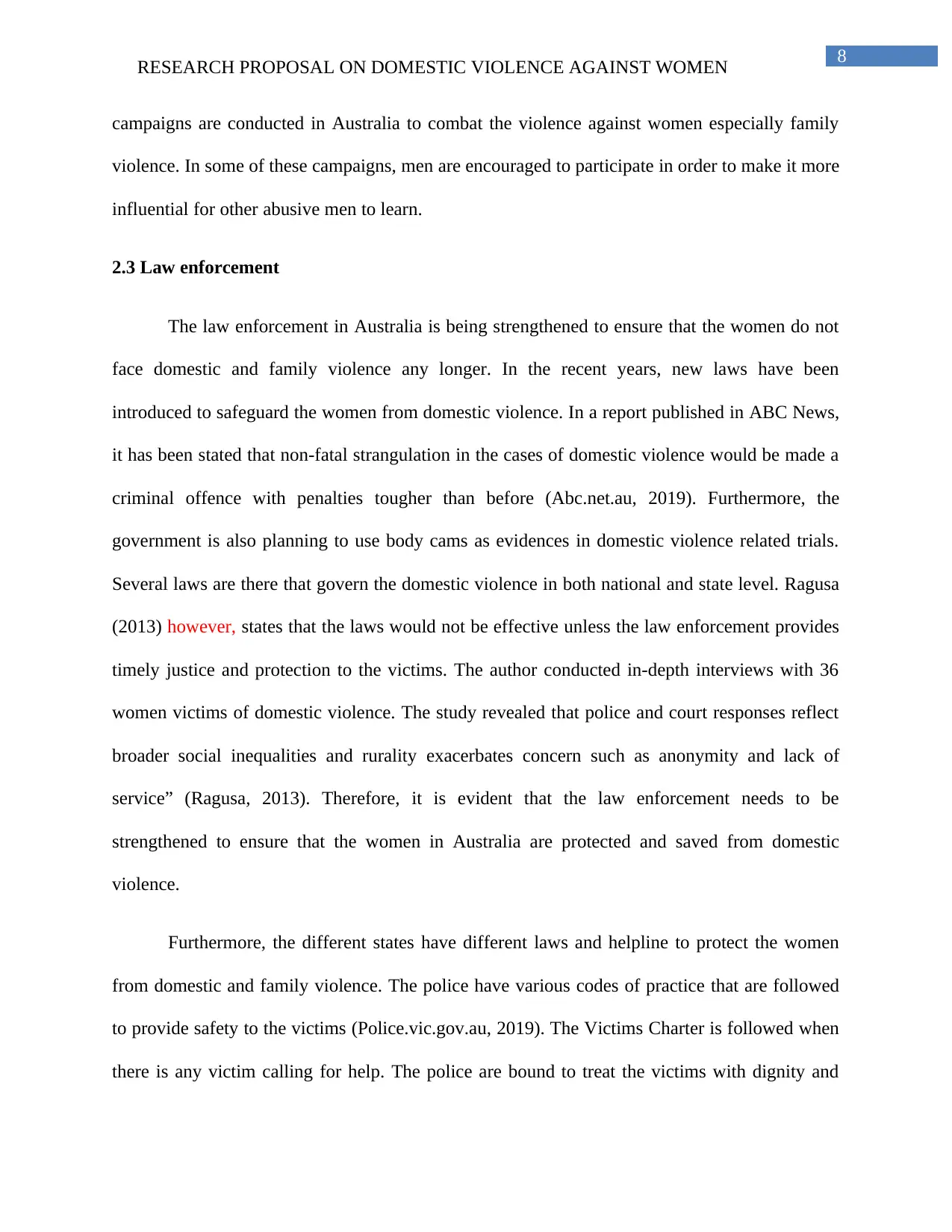
8
RESEARCH PROPOSAL ON DOMESTIC VIOLENCE AGAINST WOMEN
campaigns are conducted in Australia to combat the violence against women especially family
violence. In some of these campaigns, men are encouraged to participate in order to make it more
influential for other abusive men to learn.
2.3 Law enforcement
The law enforcement in Australia is being strengthened to ensure that the women do not
face domestic and family violence any longer. In the recent years, new laws have been
introduced to safeguard the women from domestic violence. In a report published in ABC News,
it has been stated that non-fatal strangulation in the cases of domestic violence would be made a
criminal offence with penalties tougher than before (Abc.net.au, 2019). Furthermore, the
government is also planning to use body cams as evidences in domestic violence related trials.
Several laws are there that govern the domestic violence in both national and state level. Ragusa
(2013) however, states that the laws would not be effective unless the law enforcement provides
timely justice and protection to the victims. The author conducted in-depth interviews with 36
women victims of domestic violence. The study revealed that police and court responses reflect
broader social inequalities and rurality exacerbates concern such as anonymity and lack of
service” (Ragusa, 2013). Therefore, it is evident that the law enforcement needs to be
strengthened to ensure that the women in Australia are protected and saved from domestic
violence.
Furthermore, the different states have different laws and helpline to protect the women
from domestic and family violence. The police have various codes of practice that are followed
to provide safety to the victims (Police.vic.gov.au, 2019). The Victims Charter is followed when
there is any victim calling for help. The police are bound to treat the victims with dignity and
RESEARCH PROPOSAL ON DOMESTIC VIOLENCE AGAINST WOMEN
campaigns are conducted in Australia to combat the violence against women especially family
violence. In some of these campaigns, men are encouraged to participate in order to make it more
influential for other abusive men to learn.
2.3 Law enforcement
The law enforcement in Australia is being strengthened to ensure that the women do not
face domestic and family violence any longer. In the recent years, new laws have been
introduced to safeguard the women from domestic violence. In a report published in ABC News,
it has been stated that non-fatal strangulation in the cases of domestic violence would be made a
criminal offence with penalties tougher than before (Abc.net.au, 2019). Furthermore, the
government is also planning to use body cams as evidences in domestic violence related trials.
Several laws are there that govern the domestic violence in both national and state level. Ragusa
(2013) however, states that the laws would not be effective unless the law enforcement provides
timely justice and protection to the victims. The author conducted in-depth interviews with 36
women victims of domestic violence. The study revealed that police and court responses reflect
broader social inequalities and rurality exacerbates concern such as anonymity and lack of
service” (Ragusa, 2013). Therefore, it is evident that the law enforcement needs to be
strengthened to ensure that the women in Australia are protected and saved from domestic
violence.
Furthermore, the different states have different laws and helpline to protect the women
from domestic and family violence. The police have various codes of practice that are followed
to provide safety to the victims (Police.vic.gov.au, 2019). The Victims Charter is followed when
there is any victim calling for help. The police are bound to treat the victims with dignity and
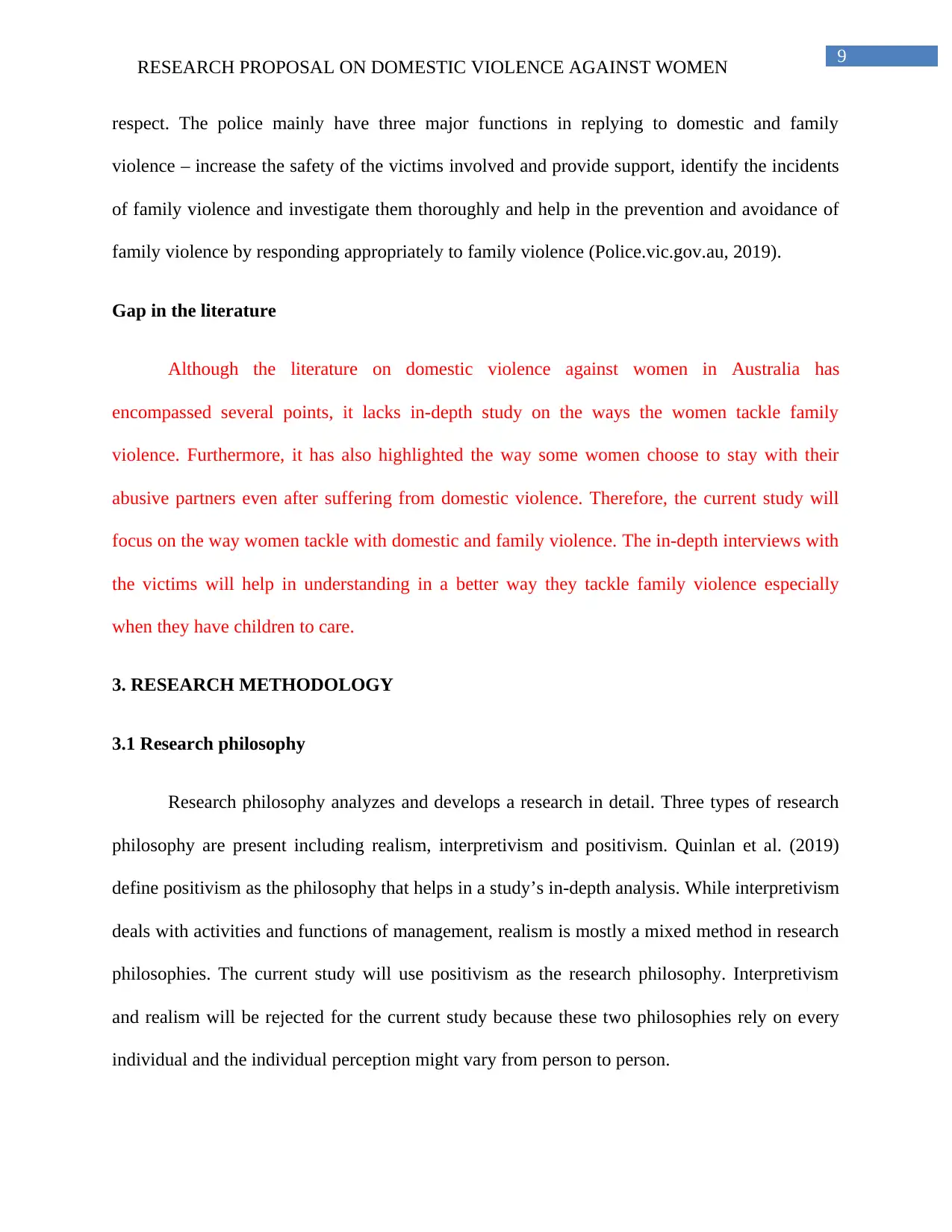
9
RESEARCH PROPOSAL ON DOMESTIC VIOLENCE AGAINST WOMEN
respect. The police mainly have three major functions in replying to domestic and family
violence – increase the safety of the victims involved and provide support, identify the incidents
of family violence and investigate them thoroughly and help in the prevention and avoidance of
family violence by responding appropriately to family violence (Police.vic.gov.au, 2019).
Gap in the literature
Although the literature on domestic violence against women in Australia has
encompassed several points, it lacks in-depth study on the ways the women tackle family
violence. Furthermore, it has also highlighted the way some women choose to stay with their
abusive partners even after suffering from domestic violence. Therefore, the current study will
focus on the way women tackle with domestic and family violence. The in-depth interviews with
the victims will help in understanding in a better way they tackle family violence especially
when they have children to care.
3. RESEARCH METHODOLOGY
3.1 Research philosophy
Research philosophy analyzes and develops a research in detail. Three types of research
philosophy are present including realism, interpretivism and positivism. Quinlan et al. (2019)
define positivism as the philosophy that helps in a study’s in-depth analysis. While interpretivism
deals with activities and functions of management, realism is mostly a mixed method in research
philosophies. The current study will use positivism as the research philosophy. Interpretivism
and realism will be rejected for the current study because these two philosophies rely on every
individual and the individual perception might vary from person to person.
RESEARCH PROPOSAL ON DOMESTIC VIOLENCE AGAINST WOMEN
respect. The police mainly have three major functions in replying to domestic and family
violence – increase the safety of the victims involved and provide support, identify the incidents
of family violence and investigate them thoroughly and help in the prevention and avoidance of
family violence by responding appropriately to family violence (Police.vic.gov.au, 2019).
Gap in the literature
Although the literature on domestic violence against women in Australia has
encompassed several points, it lacks in-depth study on the ways the women tackle family
violence. Furthermore, it has also highlighted the way some women choose to stay with their
abusive partners even after suffering from domestic violence. Therefore, the current study will
focus on the way women tackle with domestic and family violence. The in-depth interviews with
the victims will help in understanding in a better way they tackle family violence especially
when they have children to care.
3. RESEARCH METHODOLOGY
3.1 Research philosophy
Research philosophy analyzes and develops a research in detail. Three types of research
philosophy are present including realism, interpretivism and positivism. Quinlan et al. (2019)
define positivism as the philosophy that helps in a study’s in-depth analysis. While interpretivism
deals with activities and functions of management, realism is mostly a mixed method in research
philosophies. The current study will use positivism as the research philosophy. Interpretivism
and realism will be rejected for the current study because these two philosophies rely on every
individual and the individual perception might vary from person to person.
Secure Best Marks with AI Grader
Need help grading? Try our AI Grader for instant feedback on your assignments.
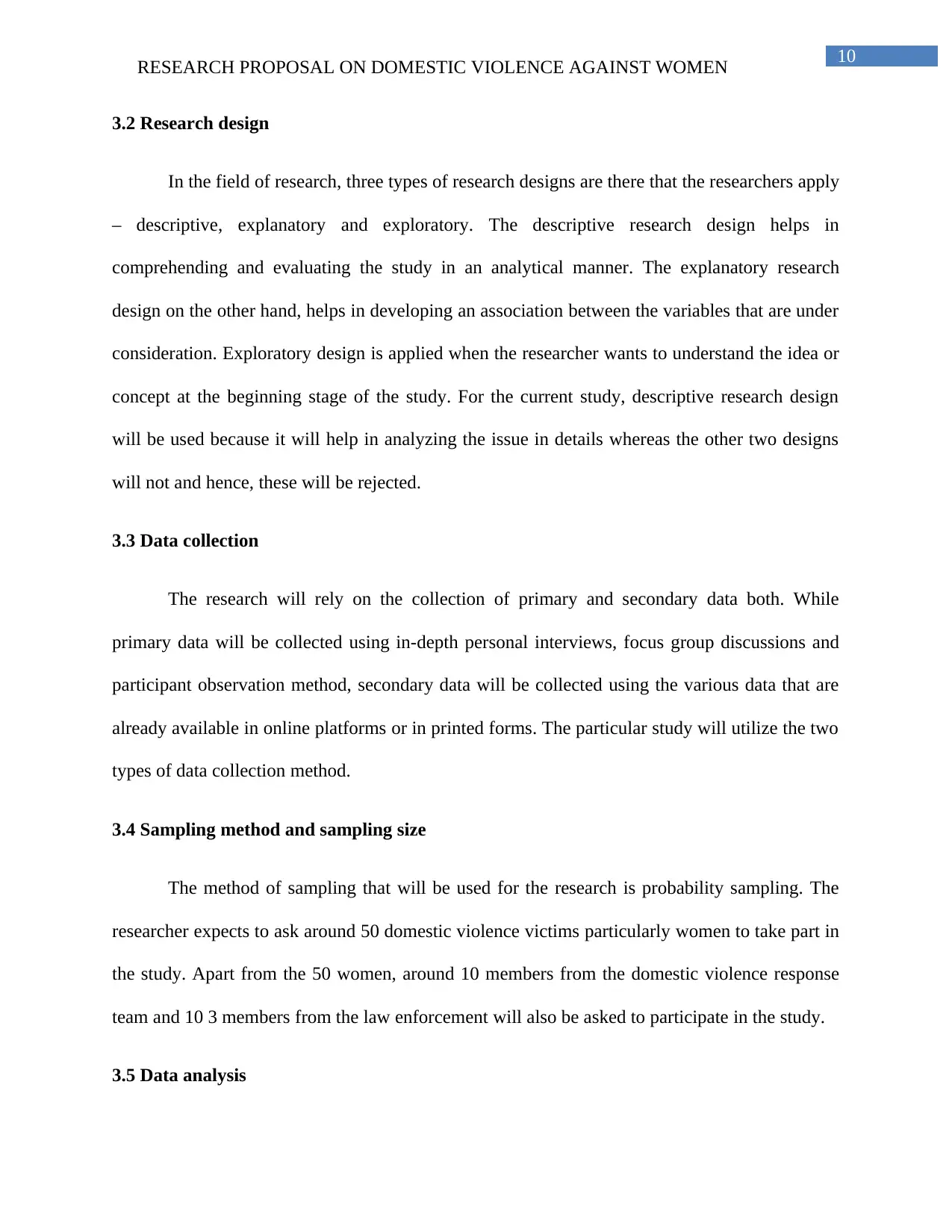
10
RESEARCH PROPOSAL ON DOMESTIC VIOLENCE AGAINST WOMEN
3.2 Research design
In the field of research, three types of research designs are there that the researchers apply
– descriptive, explanatory and exploratory. The descriptive research design helps in
comprehending and evaluating the study in an analytical manner. The explanatory research
design on the other hand, helps in developing an association between the variables that are under
consideration. Exploratory design is applied when the researcher wants to understand the idea or
concept at the beginning stage of the study. For the current study, descriptive research design
will be used because it will help in analyzing the issue in details whereas the other two designs
will not and hence, these will be rejected.
3.3 Data collection
The research will rely on the collection of primary and secondary data both. While
primary data will be collected using in-depth personal interviews, focus group discussions and
participant observation method, secondary data will be collected using the various data that are
already available in online platforms or in printed forms. The particular study will utilize the two
types of data collection method.
3.4 Sampling method and sampling size
The method of sampling that will be used for the research is probability sampling. The
researcher expects to ask around 50 domestic violence victims particularly women to take part in
the study. Apart from the 50 women, around 10 members from the domestic violence response
team and 10 3 members from the law enforcement will also be asked to participate in the study.
3.5 Data analysis
RESEARCH PROPOSAL ON DOMESTIC VIOLENCE AGAINST WOMEN
3.2 Research design
In the field of research, three types of research designs are there that the researchers apply
– descriptive, explanatory and exploratory. The descriptive research design helps in
comprehending and evaluating the study in an analytical manner. The explanatory research
design on the other hand, helps in developing an association between the variables that are under
consideration. Exploratory design is applied when the researcher wants to understand the idea or
concept at the beginning stage of the study. For the current study, descriptive research design
will be used because it will help in analyzing the issue in details whereas the other two designs
will not and hence, these will be rejected.
3.3 Data collection
The research will rely on the collection of primary and secondary data both. While
primary data will be collected using in-depth personal interviews, focus group discussions and
participant observation method, secondary data will be collected using the various data that are
already available in online platforms or in printed forms. The particular study will utilize the two
types of data collection method.
3.4 Sampling method and sampling size
The method of sampling that will be used for the research is probability sampling. The
researcher expects to ask around 50 domestic violence victims particularly women to take part in
the study. Apart from the 50 women, around 10 members from the domestic violence response
team and 10 3 members from the law enforcement will also be asked to participate in the study.
3.5 Data analysis
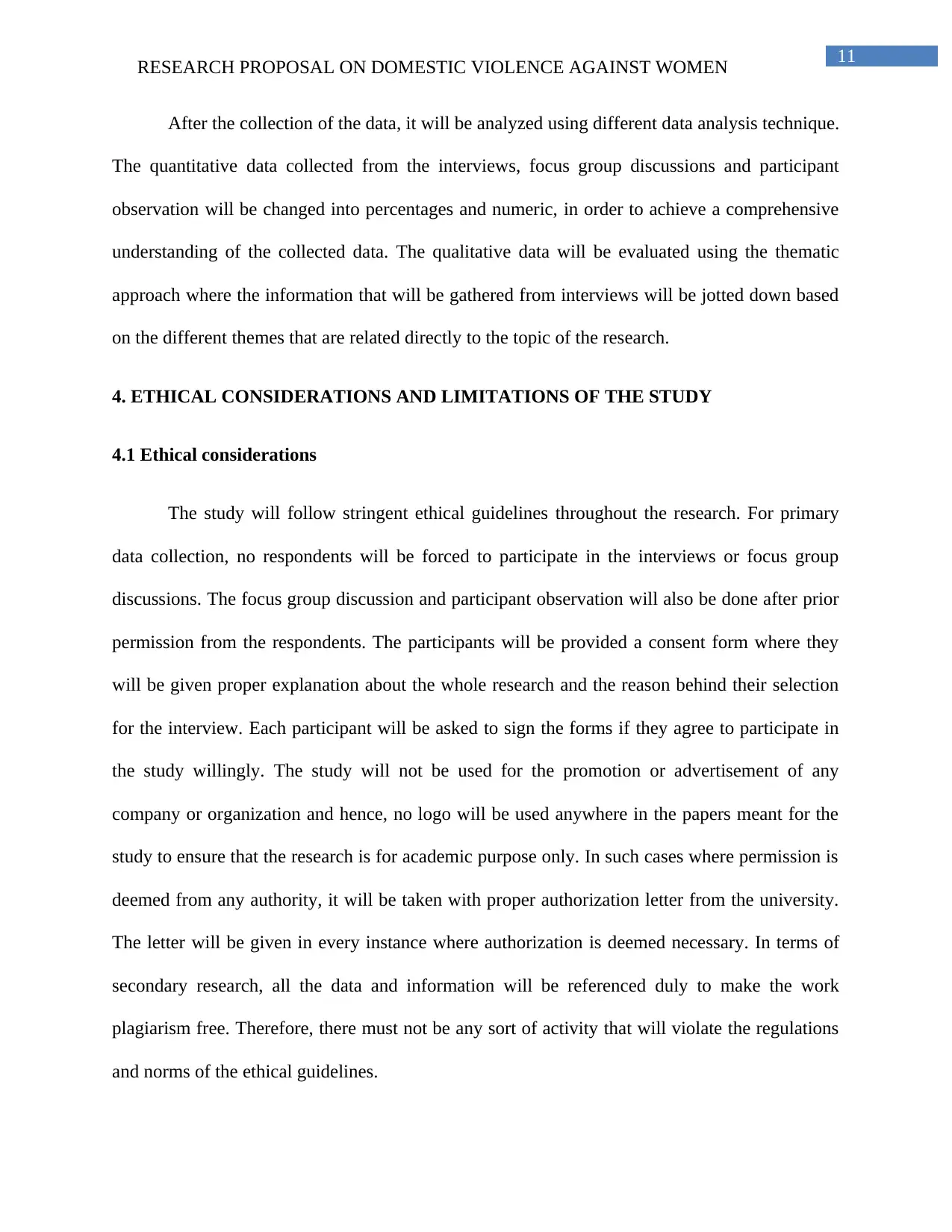
11
RESEARCH PROPOSAL ON DOMESTIC VIOLENCE AGAINST WOMEN
After the collection of the data, it will be analyzed using different data analysis technique.
The quantitative data collected from the interviews, focus group discussions and participant
observation will be changed into percentages and numeric, in order to achieve a comprehensive
understanding of the collected data. The qualitative data will be evaluated using the thematic
approach where the information that will be gathered from interviews will be jotted down based
on the different themes that are related directly to the topic of the research.
4. ETHICAL CONSIDERATIONS AND LIMITATIONS OF THE STUDY
4.1 Ethical considerations
The study will follow stringent ethical guidelines throughout the research. For primary
data collection, no respondents will be forced to participate in the interviews or focus group
discussions. The focus group discussion and participant observation will also be done after prior
permission from the respondents. The participants will be provided a consent form where they
will be given proper explanation about the whole research and the reason behind their selection
for the interview. Each participant will be asked to sign the forms if they agree to participate in
the study willingly. The study will not be used for the promotion or advertisement of any
company or organization and hence, no logo will be used anywhere in the papers meant for the
study to ensure that the research is for academic purpose only. In such cases where permission is
deemed from any authority, it will be taken with proper authorization letter from the university.
The letter will be given in every instance where authorization is deemed necessary. In terms of
secondary research, all the data and information will be referenced duly to make the work
plagiarism free. Therefore, there must not be any sort of activity that will violate the regulations
and norms of the ethical guidelines.
RESEARCH PROPOSAL ON DOMESTIC VIOLENCE AGAINST WOMEN
After the collection of the data, it will be analyzed using different data analysis technique.
The quantitative data collected from the interviews, focus group discussions and participant
observation will be changed into percentages and numeric, in order to achieve a comprehensive
understanding of the collected data. The qualitative data will be evaluated using the thematic
approach where the information that will be gathered from interviews will be jotted down based
on the different themes that are related directly to the topic of the research.
4. ETHICAL CONSIDERATIONS AND LIMITATIONS OF THE STUDY
4.1 Ethical considerations
The study will follow stringent ethical guidelines throughout the research. For primary
data collection, no respondents will be forced to participate in the interviews or focus group
discussions. The focus group discussion and participant observation will also be done after prior
permission from the respondents. The participants will be provided a consent form where they
will be given proper explanation about the whole research and the reason behind their selection
for the interview. Each participant will be asked to sign the forms if they agree to participate in
the study willingly. The study will not be used for the promotion or advertisement of any
company or organization and hence, no logo will be used anywhere in the papers meant for the
study to ensure that the research is for academic purpose only. In such cases where permission is
deemed from any authority, it will be taken with proper authorization letter from the university.
The letter will be given in every instance where authorization is deemed necessary. In terms of
secondary research, all the data and information will be referenced duly to make the work
plagiarism free. Therefore, there must not be any sort of activity that will violate the regulations
and norms of the ethical guidelines.
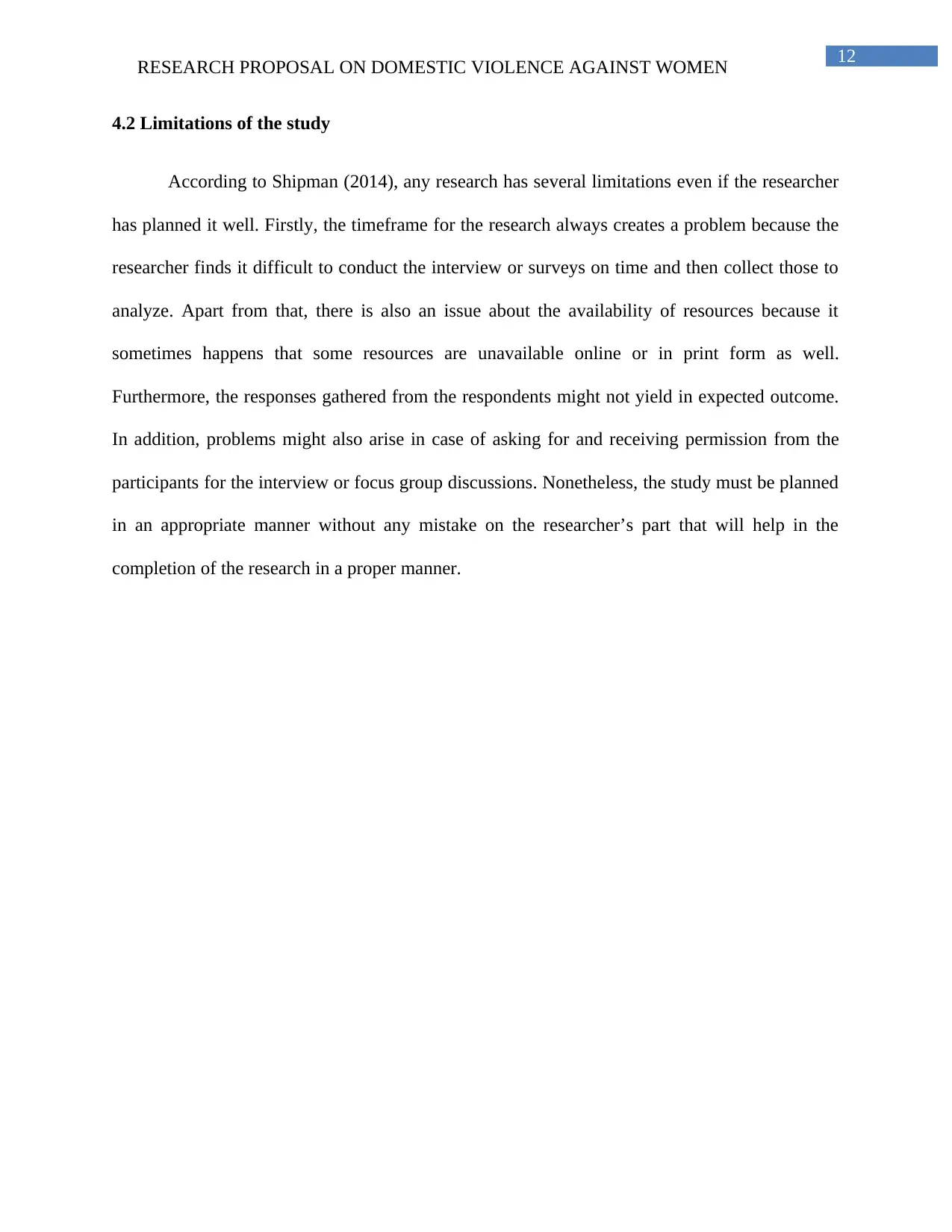
12
RESEARCH PROPOSAL ON DOMESTIC VIOLENCE AGAINST WOMEN
4.2 Limitations of the study
According to Shipman (2014), any research has several limitations even if the researcher
has planned it well. Firstly, the timeframe for the research always creates a problem because the
researcher finds it difficult to conduct the interview or surveys on time and then collect those to
analyze. Apart from that, there is also an issue about the availability of resources because it
sometimes happens that some resources are unavailable online or in print form as well.
Furthermore, the responses gathered from the respondents might not yield in expected outcome.
In addition, problems might also arise in case of asking for and receiving permission from the
participants for the interview or focus group discussions. Nonetheless, the study must be planned
in an appropriate manner without any mistake on the researcher’s part that will help in the
completion of the research in a proper manner.
RESEARCH PROPOSAL ON DOMESTIC VIOLENCE AGAINST WOMEN
4.2 Limitations of the study
According to Shipman (2014), any research has several limitations even if the researcher
has planned it well. Firstly, the timeframe for the research always creates a problem because the
researcher finds it difficult to conduct the interview or surveys on time and then collect those to
analyze. Apart from that, there is also an issue about the availability of resources because it
sometimes happens that some resources are unavailable online or in print form as well.
Furthermore, the responses gathered from the respondents might not yield in expected outcome.
In addition, problems might also arise in case of asking for and receiving permission from the
participants for the interview or focus group discussions. Nonetheless, the study must be planned
in an appropriate manner without any mistake on the researcher’s part that will help in the
completion of the research in a proper manner.
Paraphrase This Document
Need a fresh take? Get an instant paraphrase of this document with our AI Paraphraser
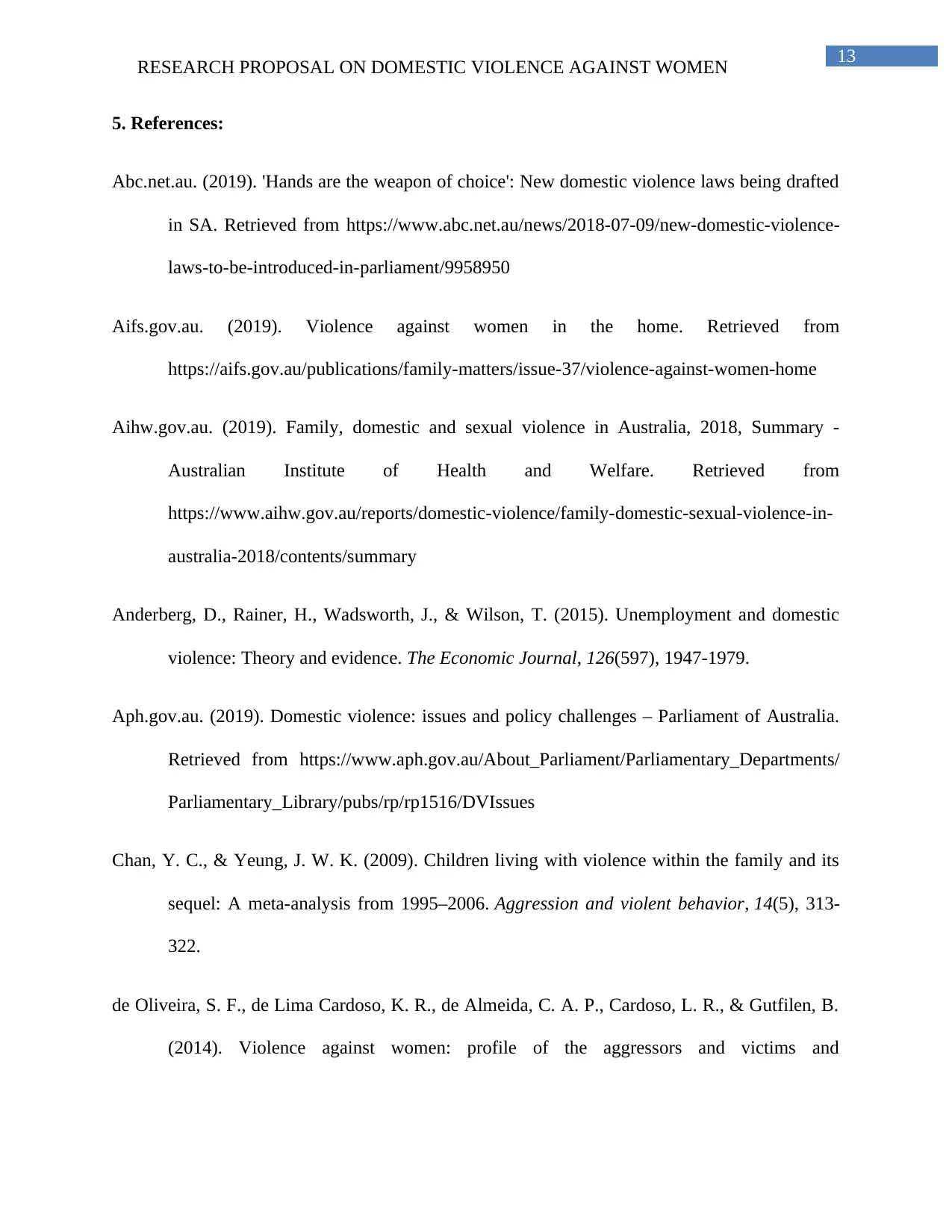
13
RESEARCH PROPOSAL ON DOMESTIC VIOLENCE AGAINST WOMEN
5. References:
Abc.net.au. (2019). 'Hands are the weapon of choice': New domestic violence laws being drafted
in SA. Retrieved from https://www.abc.net.au/news/2018-07-09/new-domestic-violence-
laws-to-be-introduced-in-parliament/9958950
Aifs.gov.au. (2019). Violence against women in the home. Retrieved from
https://aifs.gov.au/publications/family-matters/issue-37/violence-against-women-home
Aihw.gov.au. (2019). Family, domestic and sexual violence in Australia, 2018, Summary -
Australian Institute of Health and Welfare. Retrieved from
https://www.aihw.gov.au/reports/domestic-violence/family-domestic-sexual-violence-in-
australia-2018/contents/summary
Anderberg, D., Rainer, H., Wadsworth, J., & Wilson, T. (2015). Unemployment and domestic
violence: Theory and evidence. The Economic Journal, 126(597), 1947-1979.
Aph.gov.au. (2019). Domestic violence: issues and policy challenges – Parliament of Australia.
Retrieved from https://www.aph.gov.au/About_Parliament/Parliamentary_Departments/
Parliamentary_Library/pubs/rp/rp1516/DVIssues
Chan, Y. C., & Yeung, J. W. K. (2009). Children living with violence within the family and its
sequel: A meta-analysis from 1995–2006. Aggression and violent behavior, 14(5), 313-
322.
de Oliveira, S. F., de Lima Cardoso, K. R., de Almeida, C. A. P., Cardoso, L. R., & Gutfilen, B.
(2014). Violence against women: profile of the aggressors and victims and
RESEARCH PROPOSAL ON DOMESTIC VIOLENCE AGAINST WOMEN
5. References:
Abc.net.au. (2019). 'Hands are the weapon of choice': New domestic violence laws being drafted
in SA. Retrieved from https://www.abc.net.au/news/2018-07-09/new-domestic-violence-
laws-to-be-introduced-in-parliament/9958950
Aifs.gov.au. (2019). Violence against women in the home. Retrieved from
https://aifs.gov.au/publications/family-matters/issue-37/violence-against-women-home
Aihw.gov.au. (2019). Family, domestic and sexual violence in Australia, 2018, Summary -
Australian Institute of Health and Welfare. Retrieved from
https://www.aihw.gov.au/reports/domestic-violence/family-domestic-sexual-violence-in-
australia-2018/contents/summary
Anderberg, D., Rainer, H., Wadsworth, J., & Wilson, T. (2015). Unemployment and domestic
violence: Theory and evidence. The Economic Journal, 126(597), 1947-1979.
Aph.gov.au. (2019). Domestic violence: issues and policy challenges – Parliament of Australia.
Retrieved from https://www.aph.gov.au/About_Parliament/Parliamentary_Departments/
Parliamentary_Library/pubs/rp/rp1516/DVIssues
Chan, Y. C., & Yeung, J. W. K. (2009). Children living with violence within the family and its
sequel: A meta-analysis from 1995–2006. Aggression and violent behavior, 14(5), 313-
322.
de Oliveira, S. F., de Lima Cardoso, K. R., de Almeida, C. A. P., Cardoso, L. R., & Gutfilen, B.
(2014). Violence against women: profile of the aggressors and victims and
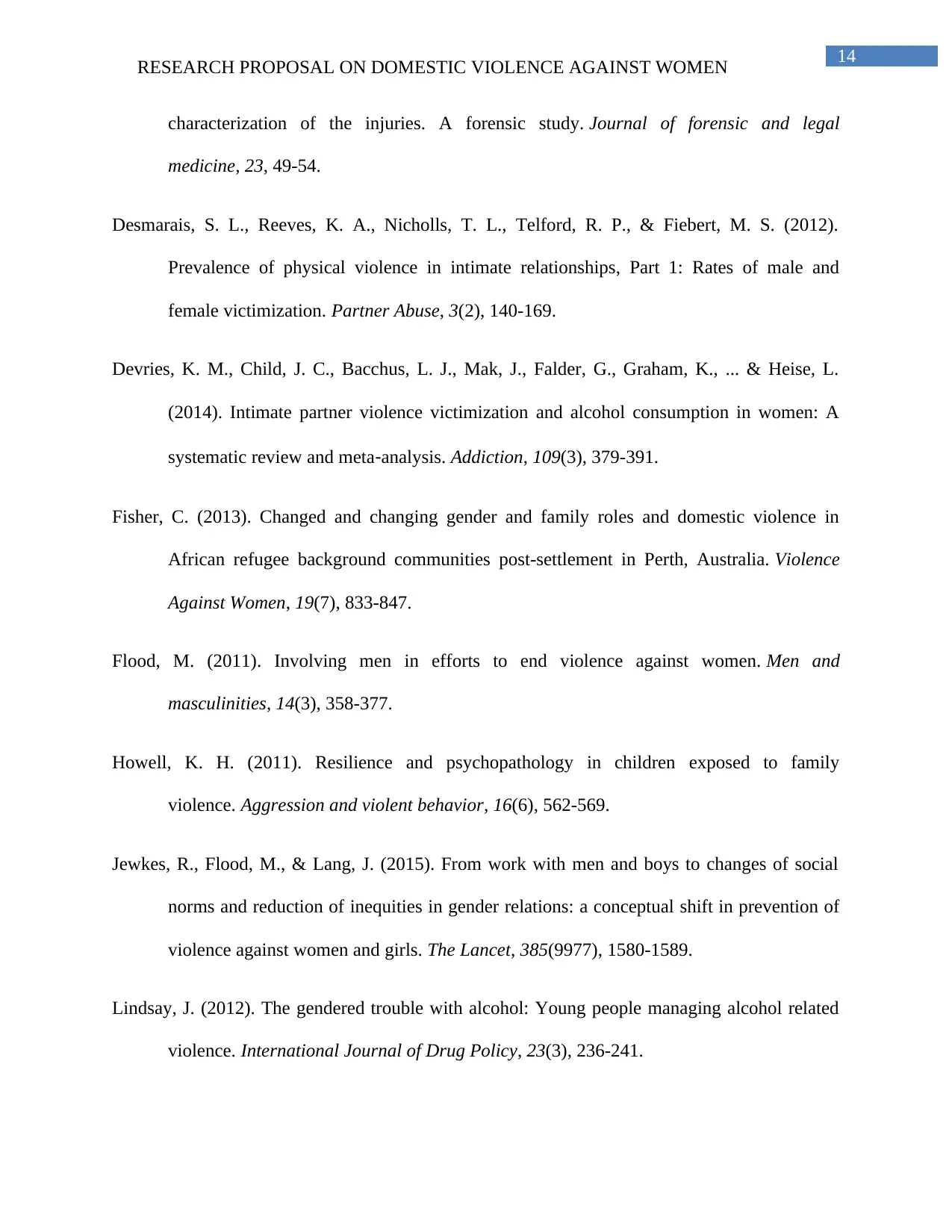
14
RESEARCH PROPOSAL ON DOMESTIC VIOLENCE AGAINST WOMEN
characterization of the injuries. A forensic study. Journal of forensic and legal
medicine, 23, 49-54.
Desmarais, S. L., Reeves, K. A., Nicholls, T. L., Telford, R. P., & Fiebert, M. S. (2012).
Prevalence of physical violence in intimate relationships, Part 1: Rates of male and
female victimization. Partner Abuse, 3(2), 140-169.
Devries, K. M., Child, J. C., Bacchus, L. J., Mak, J., Falder, G., Graham, K., ... & Heise, L.
(2014). Intimate partner violence victimization and alcohol consumption in women: A
systematic review and meta‐analysis. Addiction, 109(3), 379-391.
Fisher, C. (2013). Changed and changing gender and family roles and domestic violence in
African refugee background communities post-settlement in Perth, Australia. Violence
Against Women, 19(7), 833-847.
Flood, M. (2011). Involving men in efforts to end violence against women. Men and
masculinities, 14(3), 358-377.
Howell, K. H. (2011). Resilience and psychopathology in children exposed to family
violence. Aggression and violent behavior, 16(6), 562-569.
Jewkes, R., Flood, M., & Lang, J. (2015). From work with men and boys to changes of social
norms and reduction of inequities in gender relations: a conceptual shift in prevention of
violence against women and girls. The Lancet, 385(9977), 1580-1589.
Lindsay, J. (2012). The gendered trouble with alcohol: Young people managing alcohol related
violence. International Journal of Drug Policy, 23(3), 236-241.
RESEARCH PROPOSAL ON DOMESTIC VIOLENCE AGAINST WOMEN
characterization of the injuries. A forensic study. Journal of forensic and legal
medicine, 23, 49-54.
Desmarais, S. L., Reeves, K. A., Nicholls, T. L., Telford, R. P., & Fiebert, M. S. (2012).
Prevalence of physical violence in intimate relationships, Part 1: Rates of male and
female victimization. Partner Abuse, 3(2), 140-169.
Devries, K. M., Child, J. C., Bacchus, L. J., Mak, J., Falder, G., Graham, K., ... & Heise, L.
(2014). Intimate partner violence victimization and alcohol consumption in women: A
systematic review and meta‐analysis. Addiction, 109(3), 379-391.
Fisher, C. (2013). Changed and changing gender and family roles and domestic violence in
African refugee background communities post-settlement in Perth, Australia. Violence
Against Women, 19(7), 833-847.
Flood, M. (2011). Involving men in efforts to end violence against women. Men and
masculinities, 14(3), 358-377.
Howell, K. H. (2011). Resilience and psychopathology in children exposed to family
violence. Aggression and violent behavior, 16(6), 562-569.
Jewkes, R., Flood, M., & Lang, J. (2015). From work with men and boys to changes of social
norms and reduction of inequities in gender relations: a conceptual shift in prevention of
violence against women and girls. The Lancet, 385(9977), 1580-1589.
Lindsay, J. (2012). The gendered trouble with alcohol: Young people managing alcohol related
violence. International Journal of Drug Policy, 23(3), 236-241.
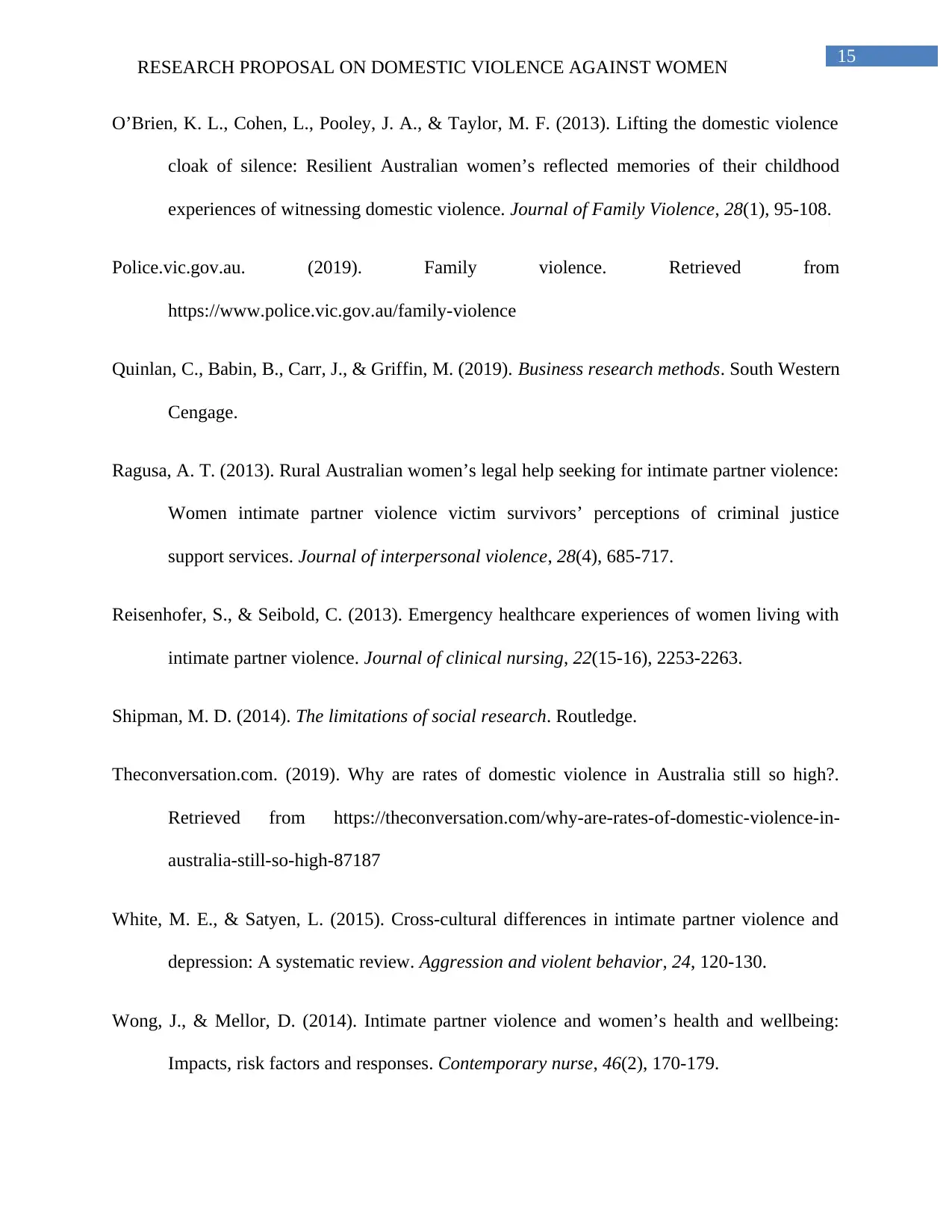
15
RESEARCH PROPOSAL ON DOMESTIC VIOLENCE AGAINST WOMEN
O’Brien, K. L., Cohen, L., Pooley, J. A., & Taylor, M. F. (2013). Lifting the domestic violence
cloak of silence: Resilient Australian women’s reflected memories of their childhood
experiences of witnessing domestic violence. Journal of Family Violence, 28(1), 95-108.
Police.vic.gov.au. (2019). Family violence. Retrieved from
https://www.police.vic.gov.au/family-violence
Quinlan, C., Babin, B., Carr, J., & Griffin, M. (2019). Business research methods. South Western
Cengage.
Ragusa, A. T. (2013). Rural Australian women’s legal help seeking for intimate partner violence:
Women intimate partner violence victim survivors’ perceptions of criminal justice
support services. Journal of interpersonal violence, 28(4), 685-717.
Reisenhofer, S., & Seibold, C. (2013). Emergency healthcare experiences of women living with
intimate partner violence. Journal of clinical nursing, 22(15-16), 2253-2263.
Shipman, M. D. (2014). The limitations of social research. Routledge.
Theconversation.com. (2019). Why are rates of domestic violence in Australia still so high?.
Retrieved from https://theconversation.com/why-are-rates-of-domestic-violence-in-
australia-still-so-high-87187
White, M. E., & Satyen, L. (2015). Cross-cultural differences in intimate partner violence and
depression: A systematic review. Aggression and violent behavior, 24, 120-130.
Wong, J., & Mellor, D. (2014). Intimate partner violence and women’s health and wellbeing:
Impacts, risk factors and responses. Contemporary nurse, 46(2), 170-179.
RESEARCH PROPOSAL ON DOMESTIC VIOLENCE AGAINST WOMEN
O’Brien, K. L., Cohen, L., Pooley, J. A., & Taylor, M. F. (2013). Lifting the domestic violence
cloak of silence: Resilient Australian women’s reflected memories of their childhood
experiences of witnessing domestic violence. Journal of Family Violence, 28(1), 95-108.
Police.vic.gov.au. (2019). Family violence. Retrieved from
https://www.police.vic.gov.au/family-violence
Quinlan, C., Babin, B., Carr, J., & Griffin, M. (2019). Business research methods. South Western
Cengage.
Ragusa, A. T. (2013). Rural Australian women’s legal help seeking for intimate partner violence:
Women intimate partner violence victim survivors’ perceptions of criminal justice
support services. Journal of interpersonal violence, 28(4), 685-717.
Reisenhofer, S., & Seibold, C. (2013). Emergency healthcare experiences of women living with
intimate partner violence. Journal of clinical nursing, 22(15-16), 2253-2263.
Shipman, M. D. (2014). The limitations of social research. Routledge.
Theconversation.com. (2019). Why are rates of domestic violence in Australia still so high?.
Retrieved from https://theconversation.com/why-are-rates-of-domestic-violence-in-
australia-still-so-high-87187
White, M. E., & Satyen, L. (2015). Cross-cultural differences in intimate partner violence and
depression: A systematic review. Aggression and violent behavior, 24, 120-130.
Wong, J., & Mellor, D. (2014). Intimate partner violence and women’s health and wellbeing:
Impacts, risk factors and responses. Contemporary nurse, 46(2), 170-179.
Secure Best Marks with AI Grader
Need help grading? Try our AI Grader for instant feedback on your assignments.

16
RESEARCH PROPOSAL ON DOMESTIC VIOLENCE AGAINST WOMEN
Zannettino, L. (2012). “... There is No War Here; It is Only the Relationship That Makes Us
Scared” Factors Having an Impact on Domestic Violence in Liberian Refugee
Communities in South Australia. Violence Against Women, 18(7), 807-828.
RESEARCH PROPOSAL ON DOMESTIC VIOLENCE AGAINST WOMEN
Zannettino, L. (2012). “... There is No War Here; It is Only the Relationship That Makes Us
Scared” Factors Having an Impact on Domestic Violence in Liberian Refugee
Communities in South Australia. Violence Against Women, 18(7), 807-828.
1 out of 17
Related Documents
Your All-in-One AI-Powered Toolkit for Academic Success.
+13062052269
info@desklib.com
Available 24*7 on WhatsApp / Email
![[object Object]](/_next/static/media/star-bottom.7253800d.svg)
Unlock your academic potential
© 2024 | Zucol Services PVT LTD | All rights reserved.





